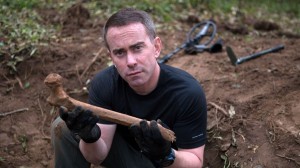updated 2:30 p.m. EST with two more links at the end of the post.
I was on campus until rather late last night and didn’t get a chance to update the list of articles critiquing and opposing the National Geographic Channel’s Nazi War Diggers, a proposed 4 part series which appeared to portray archaeology as treasure hunting and showed human remains being excavated in a grotesquely cavalier manner.
My previous link round-up posts are here: Nazi War Diggers: Part II and here: Nazi War Diggers: Part I.
There are some excellent articles that I’ll link to at the end of this post, but I’m going to start with the good news Tom Mashberg reported in the New York Times: “National Geographic Channel Pulls ‘Nazi War Diggers’ Series.”
It should be noted that the show does not appear to have officially been cancelled – it has been “postponed indefinitely,” which can mean a lot of things in the world of broadcast media and video on demand.
Still, it’s a positive sign and one that the National Geographic Channel should be given credit for, particularly in light of how firmly they seemed to be digging their heels in as recently as Friday.
I want to highlight a few sections of the article since it may be behind a paywall for some readers.
First, it’s important to note that the National Geographic Society did listen to the archaeologists affiliated with the society and acknowledged their concerns:
The channel said that after “consulting with colleagues” at the National Geographic Society, it would not broadcast the series, “Nazi War Diggers,” in May as scheduled “while questions raised in recent days regarding accusations about the program can be properly reviewed.” The show was to have been broadcast globally except in the United States.
Additionally, this section explaining that the Latvian War Museum opposed the show is important because inaccurate rumors about their involvement could have serious consequences for them in the future:
National Geographic also said that none of the items dug up during filming would be sold but instead would be donated to war museums. The critics however found a posting on a military collectors’ online forum in which Mr. Gottlieb described locating a Latvian war helmet in June and preparing it for sale.
On to the links I intended to post yesterday, which raise many relevant questions and concerns and explain why NatGeo TV’s defensive arguments on Friday were so problematic.
I think these are vital reads regardless of the fate of the show because they get to a lot of larger issues that archaeologists, public historians, curators, and others face on a regular basis, particularly in the age of Infotainment and manufactured television “reality.”
Sam Hardy at Conflict Antiquities: ‘No trouble with customs.’ Perhaps trouble with repeatedly written confessions?
Alison Atkin at Deathsplanation: “On the Importance of Context.”
updates:
Andy Brockman at Heritage Daily: Springtime for Hitler and “Nazi War [Death Porn] Diggers”
Additionally, this letter from the Presidents of a number of major anthropological and archaeological professional organizations has been added to the American Anthropological Association site:
The Society for American Archaeology (SAA), the Society for Historical Archaeology (SHA), the Archaeological Institute of America (AIA), the American Anthropological Association (AAA), the European Association of Archaeologists (EAA), and the European Association of Social Anthropologists (EASA) wish
to express our deep disappointment and grave concern about the upcoming National Geographic Channel
International’s (NGCI’s) show, Nazi War Diggers. Together, SAA, SHA, AIA, AAA, EAA, and EASA
represent more than 10,000 professional archaeologists and more than 600,000 individuals interested in
archaeology. Our members live and work in all parts of the world, including the areas ravaged by World
War II.
